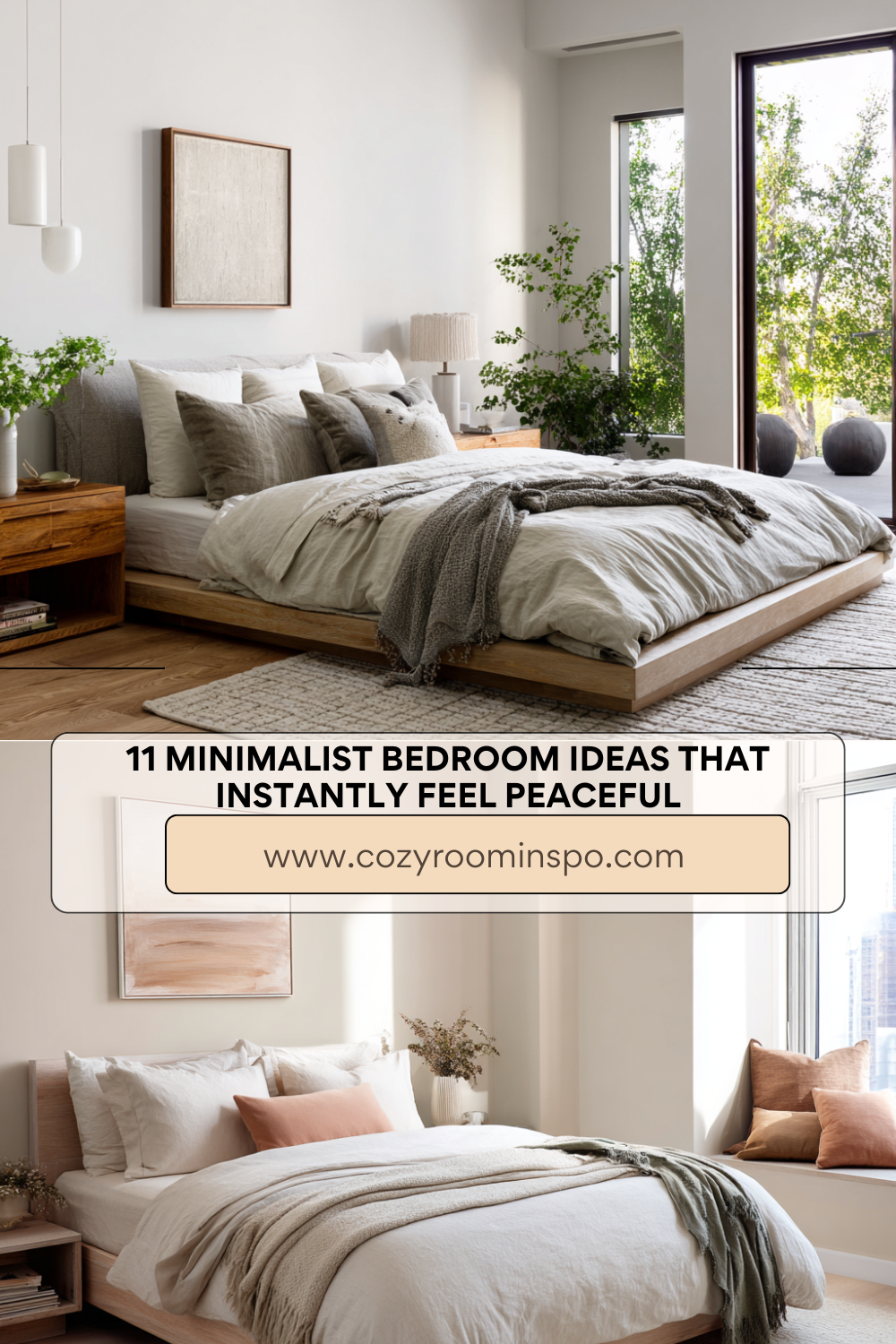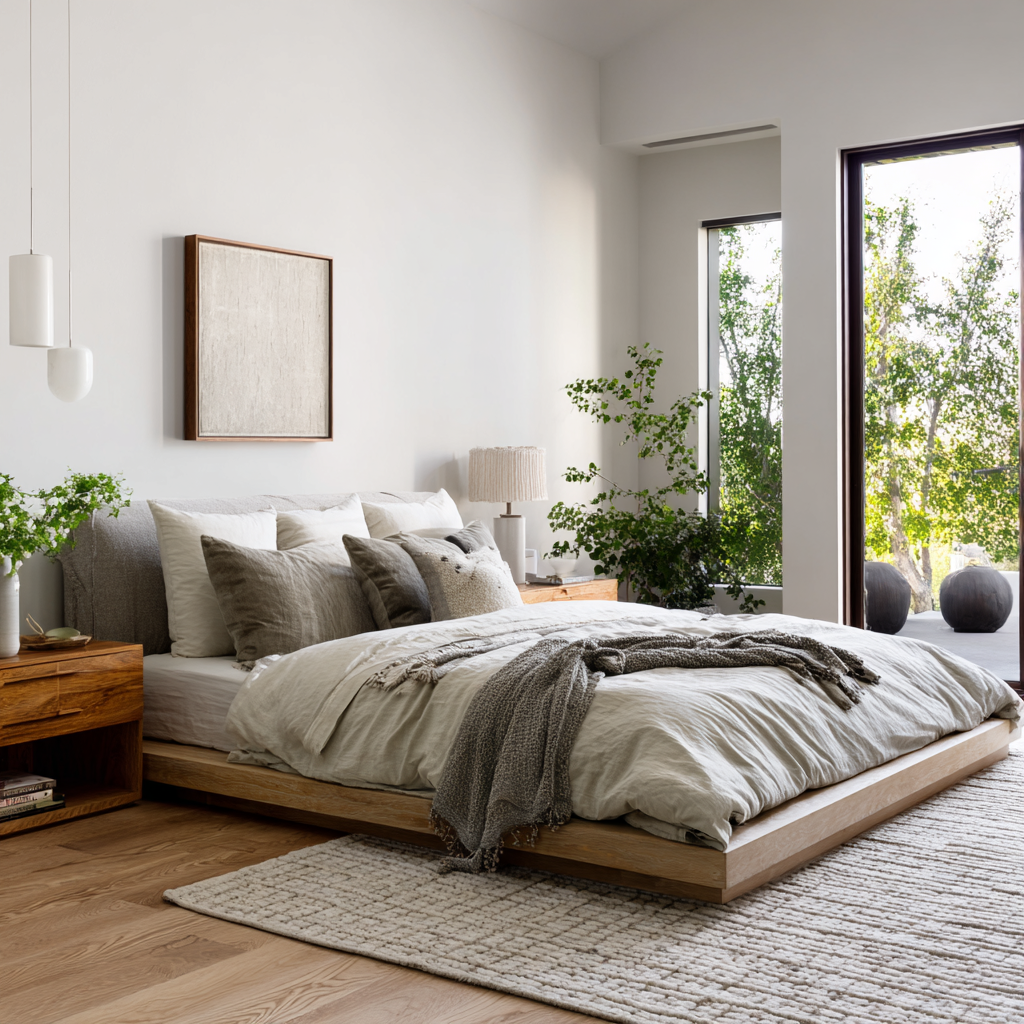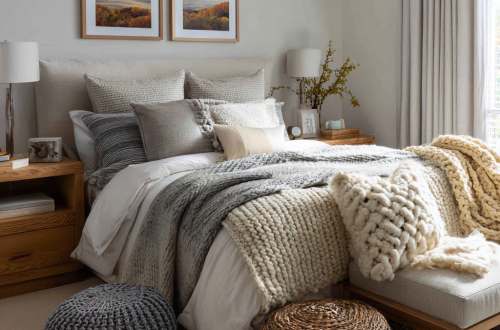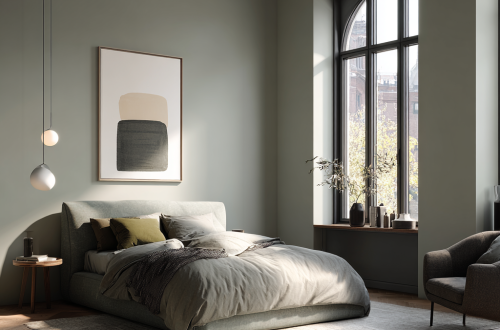11 Minimalist Bedroom Ideas for a Calming Refuge
Let’s be honest—life is hectic. Between busy mornings and long workdays, our bedrooms should feel like an escape, not another source of stress. That’s where minimalist design comes in. Clean lines, thoughtful touches, and clutter-free spaces make room for calm, clarity, and seriously good sleep.
If you’re ready to turn your bedroom into a peaceful haven, you’re in the right place. I’ve gathered 11 minimalist bedroom ideas that will help you design a calming refuge—no fancy budget or design degree required.

1. Stick to a Soft, Neutral Color Palette
The foundation of a calming minimalist bedroom is color. Soft, neutral hues—think white, beige, greige, soft taupe, or muted sage—invite calm into your space without trying too hard. These tones help reflect light and open up your room, even if it’s on the smaller side.
Try painting your walls a soft white and layering in light wood furniture and linen curtains. Keep your bedding simple with light grey or warm ivory sheets and add one or two accent pillows in a calming tone like dusty rose or eucalyptus green. You’re not aiming for boring—you’re creating harmony.
Neutrals also make it easier to swap out decor with the seasons or your mood. Instead of repainting or buying new furniture, you can refresh your space with a new throw or artwork. Minimalism doesn’t mean never changing anything—it just means curating carefully so your room always feels right.

2. Embrace Low-Profile Furniture
One of the secrets to a serene space is low-profile furniture. Lower beds, nightstands, and dressers keep your line of sight uncluttered and help the room feel open and airy. It’s also a subtle nod to Japanese and Scandinavian design, which are both minimalist at heart.
Opt for a platform bed without a headboard or go with a simple upholstered one in a neutral tone. Choose nightstands with clean lines and open space underneath—bonus points if they include hidden drawers. And if you need extra storage, go for a low dresser that hugs the wall and doesn’t dominate the room.
The idea is to keep everything below eye level and let vertical space breathe. This trick makes even a small bedroom feel like a luxury suite.

3. Declutter Like You Mean It
This one might sound obvious, but it’s the most important: get rid of the stuff you don’t need. Visual clutter creates mental clutter. That half-used lotion on the nightstand? That laundry basket that never gets emptied? They’re adding stress without you even realizing it.
Start by clearing all surfaces. Then go drawer by drawer and shelf by shelf. Ask yourself if each item belongs in a restful space. If not, give it a new home—or donate it. Keep only what you truly use and love in your bedroom.
Once you’ve decluttered, implement easy systems to stay tidy. A basket for dirty laundry. A catch-all drawer for tech. A tray for your bedtime essentials. Minimalism isn’t about having nothing—it’s about having what matters most, organized in a way that brings you peace.

4. Use Natural Light to Your Advantage
Lighting transforms a space. In a minimalist bedroom, natural light should be the star. It softens edges, warms colors, and invites calm energy into the room. If you’re lucky enough to have a window, use it.
Skip the heavy blackout curtains and go with sheer panels that let sunlight in while maintaining privacy. You can layer them over a simple roller shade if you need extra light control. Consider using white or light wood curtain rods to keep the look cohesive.
In the evenings, add warmth with a mix of soft lighting—think a bedside lamp with a fabric shade, a dimmable floor lamp, or even fairy lights tucked subtly around the headboard. Avoid overhead lighting that feels too harsh or clinical. The goal is to mimic the soft transitions of natural daylight.

5. Choose Quality Over Quantity in Decor
Minimalist doesn’t mean empty—it means intentional. Instead of filling every wall or surface, choose one or two meaningful pieces that make your heart sing. Maybe it’s a piece of abstract art above the bed. A handmade ceramic vase. A dried floral arrangement in a glass bottle.
These items add personality without creating visual chaos. Stick to a tight color palette and mix textures like linen, matte ceramic, warm wood, and brushed metal for dimension. And give each piece room to breathe—your eyes (and brain) will thank you.
It also helps to rotate decor with the seasons. You can keep your space fresh without accumulating clutter by swapping in a new pillow cover or switching out art prints a couple times a year.

6. Simplify Your Bedding Situation
The bed is the centerpiece of your room, so it deserves thoughtful attention. But that doesn’t mean piling on throw pillows and layers of bedding. Instead, focus on comfort and simplicity.
Choose breathable fabrics like cotton, linen, or bamboo. Go with a solid or subtle pattern in neutral colors. Stick to two pillows per sleeper, one cozy blanket, and maybe one decorative pillow or lumbar cushion.
A minimalist bed invites you to dive in without fuss. Plus, it makes morning tidying a breeze—no more wrestling with eight accent pillows every time you make the bed.

7. Add Texture with Purpose
One of the most common misconceptions about minimalist bedrooms is that they have to feel cold. Not true! The trick is using texture to add depth and coziness without clutter.
Think: a chunky knit throw over the end of the bed. A woven basket in the corner. A jute rug underfoot. Linen curtains swaying in the breeze. A velvet accent pillow. When you layer textures in a neutral palette, your room feels calm, not flat.
Just remember the rule of balance. If your bedding is heavily textured, go for smoother decor on the nightstand. If you’ve got a fluffy rug, keep wall art simple. Texture should whisper, not shout.

8. Keep the Nightstand Bare (Almost)
Let’s talk nightstands. It’s so tempting to let them collect stuff: books, chargers, old water glasses, lotions, lip balm… the list goes on. But in a minimalist bedroom, a cluttered nightstand can unravel the whole vibe.
Stick to the essentials: a soft lamp, maybe a book or two, and a catch-all tray for glasses or a hair tie. If you need to charge your phone overnight, use a cable organizer or tuck it inside a drawer.
You don’t have to go full monk-mode—just make sure everything on the nightstand is either useful or beautiful. That way, the space feels clean and restful when you reach for the light each night.

9. Incorporate Greenery (But Keep It Low-Maintenance)
A touch of nature brings any minimalist bedroom to life. But you don’t need to turn your space into a jungle to enjoy the benefits of greenery.
Go for one or two low-maintenance plants—like a snake plant, peace lily, or pothos—and place them thoughtfully. One on the dresser. One on a floating shelf. Maybe a tiny succulent on the nightstand.
Plants clean the air, add a pop of color, and create a sense of balance. Just make sure the pots match your aesthetic—clay, concrete, white ceramic, or woven baskets all work beautifully in a minimalist space.

10. Opt for Hidden Storage Solutions
Minimalist bedrooms look neat because smart storage hides the mess. If you’ve decluttered but still need space for out-of-season clothes, linens, or extra stuff, it’s time to get clever.
Try under-bed storage bins with wheels. Use a bed frame with built-in drawers. Add wall-mounted shelves with baskets or boxes. Use a bench at the foot of the bed that opens for extra blanket storage.
And here’s a pro tip: label things. It might sound boring, but labeled bins keep you from digging through piles later. That way, your clean space stays clean—and your future self will be grateful.

11. Make Space for Stillness
Last but definitely not least: create a moment of pause in your bedroom. This could be a cozy reading nook by the window. A simple chair with a throw and a stack of books. A tiny altar with a candle and a journal. Whatever helps you slow down.
In a world that demands constant stimulation, minimalist bedrooms offer a sanctuary. A place to unplug, unwind, and reconnect with yourself. You deserve that stillness—and your bedroom can be the start of it.

Final Thoughts
Minimalism isn’t about perfection—it’s about peace. It’s about creating a bedroom that supports your rest, reflects your style, and frees your mind from the visual noise of everyday life. Whether you adopt one idea or all eleven, the goal is the same: a calming refuge that feels like home.
Now tell me—which idea are you trying first?





